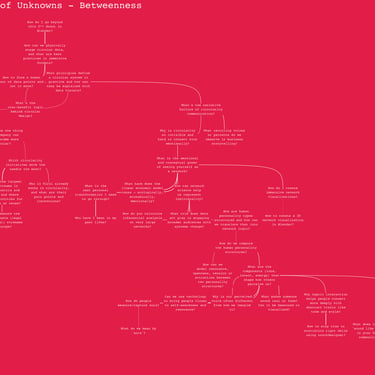Success comes more from realizing what we don’t know than from what we know.
Instead of chasing answers, what if we mapped our questions? In this post, I share how I turned my deepest, recurring uncertainties into a data-driven network — using sentence embeddings, similarity matrices, and graph theory to visualize the invisible structure behind my thoughts. What emerged wasn't just a tangle of questions, but a clear map of meaning — revealing the few core questions that silently shape everything else. A reflection on awareness, complexity, and how our unknowns might just be our greatest guides.
Lisa Lechner
8/1/20253 min read
In a world obsessed with answers, I’ve found greater breakthroughs by studying my own uncertainties. The questions I carry — the ones that return at night, resurface in projects, or quietly steer my decisions — hold more power than I often admit. But these questions don’t live in isolation. They form a web of meaning, shaping how I think, create, and act.
So I started mapping them.
Instead of treating my questions as abstract noise, I treated them as data. I gathered the most pressing open-ended, unresolved, sometimes uncomfortable inquiries. Then I used natural language processing to quantify how these questions relate to each other — not by topic, but by semantic similarity. In other words, I asked: Which of these questions speak to the same deeper concerns?
By transforming language into high-dimensional vectors using sentence embeddings, I was able to measure the conceptual closeness of every pair of questions. The result was a dense similarity matrix — a network of questions, weighted by meaning.
But clarity doesn’t come from complexity alone. To distill the signal, I constructed a maximum spanning tree: a structure that keeps only the strongest semantic connections and eliminates the rest. What emerged was not a tangled graph, but a clean conceptual skeleton — a network where each question connects only to its most meaningful counterpart.
With this process I intended to identify the questions I need to answer first so that all other questions become easy or irrelevant. And it worked. I created a map of my unknowns.
Certain questions consistently emerged near the root. They weren’t always the loudest or most urgent, but they were the ones most chosen by others — the ones other thoughts seemed to rely on. They acted as silent organizers of my mental landscape, as if my mind had already decided which questions matter most, without telling me directly.
These “needle-moving” questions form the backbone of my thinking. They structure other ideas, they lead to deeper exploration, and they reflect the real themes I’m working through — not just in theory, but in practice. They are the why behind the why behind the why.
This isn’t just a technical exercise. It’s a tool for awareness. In turning my questions into data, I turned them into a mirror. And what I saw was not a list of problems to solve, but a map of what really drives me.
But once the map existed, I faced a different kind of question: how do I read it? Not all questions are equal. Some are more foundational. Some connect distant parts of thought. Some quietly sit downstream, waiting for other ideas to resolve first. To understand how these questions function in the network — and how to choose where to begin — I turned to two metrics: depth and betweenness.
I start with depth, because it tells me which questions move the needle. Depth measures how far a question sits from the root of the tree — the conceptual starting point. A question with low depth is upstream: foundational, organizing, often quietly powerful. Higher-depth questions, by contrast, are downstream — they depend on others, are more specific, and often dissolve once upstream questions are clarified. When I feel overwhelmed or entangled, depth helps me find the few core questions that make the rest easier or even irrelevant. These are the keystone questions — the ones that unlock the rest. Also in my case I find the big picture question at the top of the depth-tree.
If I feel blocked between ideas, like I’m working in separate parts of my brain that won’t quite connect, I turn to betweenness. This metric highlights questions that sit on the path between other questions — the connectors. These are rarely the loudest questions, but they’re often the most strategic. In my map of unknowns, I noticed that technical questions often rank high in betweenness. That insight made sense: my methodological and technical approaches are what bridge otherwise separate projects. Moving forward on those unlocks the sense that everything is connected again.
Each metric reveals something different. Depth shows me what’s foundational. Betweenness shows me what connects. And together, they help me move not just toward answers, but toward clarity — the kind that reshapes how I think.
If you ever feel lost in your own complexity, try mapping your questions.
The patterns you find might be more revealing than the answers you’re chasing. I’m also happy to share the code if you want to replicate the process. Just shout out.




